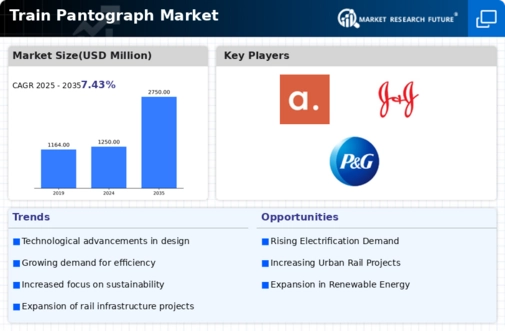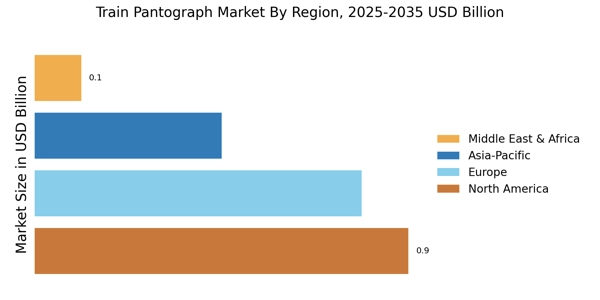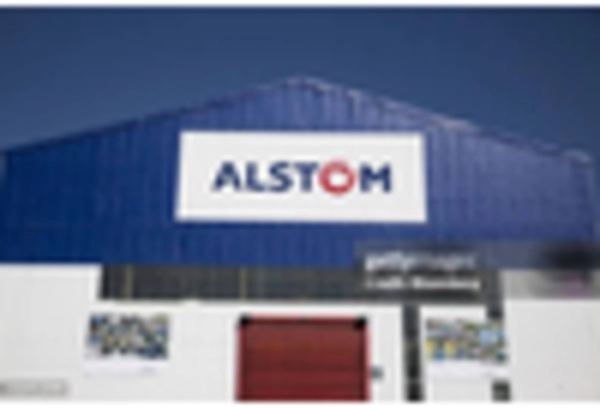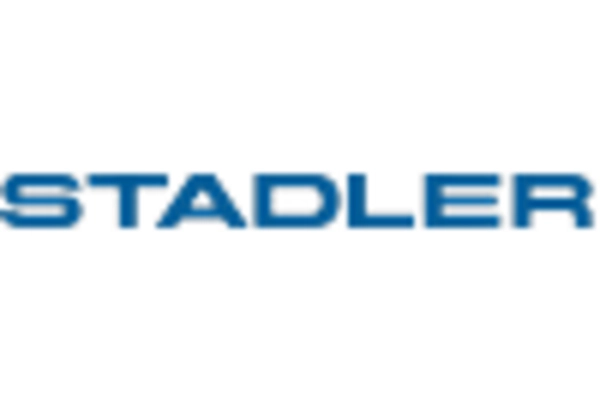Expansion of High-Speed Rail Networks
The expansion of high-speed rail networks is driving growth in the Train Pantograph Market. As countries invest in high-speed rail projects to improve connectivity and reduce travel times, the demand for efficient pantographs becomes critical. High-speed trains require advanced pantograph systems that can maintain stable contact with overhead lines at elevated speeds. Recent data indicates that high-speed rail networks are projected to grow significantly, with several new lines under construction or planned. This expansion necessitates the development and deployment of specialized pantographs designed for high-speed operations. Therefore, the Train Pantograph Market is likely to experience increased demand as rail operators seek to enhance their high-speed services.
Government Investments in Rail Infrastructure
Government investments in rail infrastructure are significantly influencing the Train Pantograph Market. Many nations are allocating substantial budgets to upgrade and expand their rail networks, recognizing the importance of efficient public transport systems. For instance, recent reports indicate that several countries are investing billions in rail infrastructure projects, which include the installation of advanced pantograph systems. These investments not only enhance the reliability and safety of rail services but also stimulate economic growth. As governments prioritize sustainable transport solutions, the demand for high-quality pantographs is likely to increase. This trend suggests a favorable environment for manufacturers and suppliers within the Train Pantograph Market, as they align their offerings with the evolving needs of rail operators.
Increasing Demand for Electrified Rail Systems
The rising demand for electrified rail systems is a primary driver in the Train Pantograph Market. As countries strive to enhance their rail networks, the shift towards electrification is evident. This transition not only improves energy efficiency but also reduces greenhouse gas emissions. According to recent data, electrified rail systems can reduce energy consumption by up to 30% compared to diesel alternatives. Consequently, the need for efficient pantographs, which facilitate the transfer of electricity from overhead lines to trains, is expected to grow. This trend indicates a robust market for pantographs, as rail operators seek to modernize their fleets and comply with environmental regulations. The Train Pantograph Market is thus poised for expansion, driven by the electrification of rail systems.
Technological Innovations in Pantograph Design
Technological innovations in pantograph design are reshaping the Train Pantograph Market. Recent advancements have led to the development of lightweight materials and improved aerodynamic designs, enhancing the performance and efficiency of pantographs. These innovations are crucial as they contribute to reduced wear and tear on both the pantograph and the overhead lines, thereby lowering maintenance costs. Furthermore, the integration of smart technologies, such as sensors and monitoring systems, allows for real-time performance tracking. This capability is increasingly sought after by rail operators aiming to optimize their operations. As a result, the Train Pantograph Market is likely to witness a surge in demand for technologically advanced pantographs that offer enhanced durability and efficiency.
Growing Focus on Sustainable Transportation Solutions
The growing focus on sustainable transportation solutions is a key driver in the Train Pantograph Market. As environmental concerns escalate, there is a concerted effort to reduce carbon footprints associated with transportation. Rail systems, particularly electrified ones, are viewed as a more sustainable alternative to road transport. The adoption of pantographs, which enable electric trains to operate efficiently, aligns with this sustainability agenda. Recent studies suggest that transitioning to electric trains can lead to a significant reduction in emissions, making pantographs essential components in this shift. Consequently, the Train Pantograph Market is expected to benefit from the increasing emphasis on eco-friendly transport solutions, as rail operators seek to enhance their sustainability profiles.


















Leave a Comment